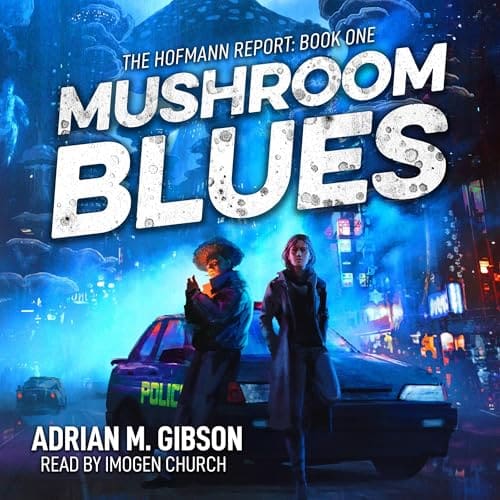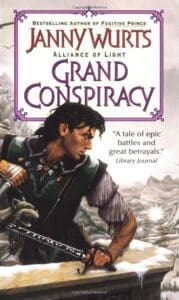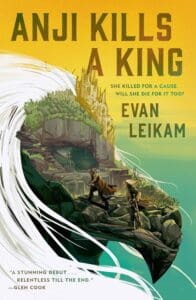
Synopsis
ENTER THE FUNGALVERSE
SPFBO X 2nd place. Shortlisted for the British Fantasy Award for Best Newcomer. Winner of the FanFiAddict Award for Best Indie Debut, the Literary Titan Gold Book Award, and the Next Generation Indie Book Award.
BLADE RUNNER, TRUE DETECTIVE, and DISTRICT 9 meld with the weird worlds of JEFF VANDERMEER and CHINA MIÉVILLE in Adrian M. Gibson’s award-winning fungalpunk noir debut.
TWO YEARS AFTER a devastating defeat in the decade-long Spore War, the island nation of Hoppon and its capital city of Neo Kinoko are occupied by invading Coprinian forces. Its Fungal citizens are in dire straits, wracked by food shortages, poverty, and an influx of war refugees. Even worse, the corrupt occupiers exploit their power, pushing the native populace toward the brink of civil unrest.
As a winter storm looms over the metropolis, NKPD Homicide Detective Henrietta Hofmann begrudgingly partners up with mushroom-headed patrol officer Koji Nameko to investigate the mysterious murders and disappearances of fungal and half-breed children. Their investigation drags them deep into the seedy underbelly of a war-torn city, one brimming with colonizers, criminal gangs, racial division, and moral decay.
In order to solve the case and unravel the truth, Hofmann must challenge her past and embrace Fungal ways. What she and Nameko uncover in the midst of this frigid wasteland will chill them to the core, but will they make it through the storm alive?
Review
Exiled to the island nation of Hōppon, homicide detective Henrietta Hoffman is assigned the thankless case of investigating the murder of a dismembered mushroom child. Tensions are high between humans the fungal Hōpponese two years after the end of the decade-long Spore War and humanity’s invasion and subsequent military occupation of the island. Hoffman’s crime scene quickly devolves into a riot between Neo Kinoko police and the growing crowd of angry Hōppons, and that’s just for starters.
Canadian author Adrian Gibson’s debut cements the dark and gritty tone of Mushroom Blues’s hardboiled detective noir right from the outset. He doesn’t pull any punches along the way either. What follows is an exploration of colonialism and racism, with Hoffman continually finding her preconceptions about the Hōppon people and their culture challenged. She’s not particularly thrilled when her captain forces her to work alongside the only fungal in the NKPD, Koji Nameko, who is viewed by his people as a traitor to their race. Their partnership is a bumpy one, and Gibson puts a smart spin on the usual buddy cop formula with their vastly different personalities, morals, and ethics oftentimes putting them at odds with one another as much as the criminal forces they find themselves up against.
Hoffman herself doesn’t ingratiate herself with readers right off the bat, either. She’s offensive, rude, belligerent, and supremely racist against the Hōpponese. She’s bought into the propaganda of humanity’s party line that theirs is a superior species and that the fungals are beneath them, and she routinely hurls half a dozen racial slurs their way. For her, these mushroom people aren’t people at all – they’re sporesacks, molders, gillies, and hopheads. She’s also deeply traumatized thanks to her own mistakes as a recovering alcholic with too many years under her belt of investigating humanity at its most inhumane. She’s angry at everything, herself most of all, and she lets everyone know it.
Gibson draws a number of parallels between post-WWII Japan, British colonialism and American racism, the latter feeling particularly topical now amidst unhinged ICE raids across the country and the recent military occupation of Los Angeles, with the US’s Dear Leader promising to deploy armed forces to more Democrat-led cities soon. The island nation of Hōppon and its people are transparently Japanese analogs, but with a few twists and mushroom-centric embellishments to better define their beliefs and culture, providing a degree of separation that prevents them from being simple Asian-inspired stand-ins. Gibson does a swell job of bringing in actual mushroom science, like the Hōppon’s mycelial network, and expounding it into something evolved and extraterrestrial. It’s a natural part of their world, but also serves to separate them from humanity and point toward something potentially darker and, at times, threatening.
Gibson’s world building is on point, with Neo Kinoko coming alive in vivid detail. It feels real, from the city’s bustling streets and military checkpoints to its people still reeling from the Spore War and the devastation it’s wrought and the foods they find comfort in and which bind them as a culture, but also alien with its towering fungal constructs and mushroom-based technologies. There’s much to be said about the well-earned resentments on both sides, but it’s clear from the outset who our sympathies are meant to lie with. Although our central viewpoint through this war-torn, militarily occupied world is Hoffman, Gibson plays it smart and isn’t content to give us just another ethnocentric work of copaganda, choosing instead to build upon the complexities of post-war policing in a world that Hoffman’s people are responsible for decimating. Nameko helps to open her eyes to the realities of the world around her and erode her misconceptions about the Hōpponese, but even by book’s end it’s clear she still has plenty of work to do. For many of the Hōpponese she’ll always be nothing more than just another human invader, a colonizer and genocider, and it’s certainly not difficult to understand their point of view.
Bringing Hoffman to life even beyond Gibson’s crisp writing is narrator Imogen Church. Church acquits herself fairly well here, but with a few minor issues. I couldn’t help but find some of her work, particularly when voicing male side characters, to be much too exaggerated and tonally inconsistent, not to mention downright shrill at times. She’s at her best when she keeps things subdued, but occasionally launches into scenery-chewing overacting that feels out of place. The production value is top-notch, though, thanks to Chelo Suarez, who introduces some neat audio effects, such as when police give orders through a bullhorn. Each chapter is fronted by original pieces of music by Sporer, most lasting only a few seconds, but which give the book a nice bit of funk.
Mushrooms and spores have long been a staple of weird fiction and horror stories, but I wasn’t aware of the SFF subgenre of fungalpunk until Mushroom Blues caught my attention earlier this year. Now that I know about it, I want more, from this genre and this author particularly. I’ll be getting my wish soon, thankfully, with Gibson having recently announced his follow-up, A Murder Most Fungal, a stand-alone novella set within Blues’s fungalverse. As for what this fungalverse is – think part Blade Runner, part Alien Nation, all ‘shrooms. Combined, it makes for a rich, lucious, and highly addictive duxelles.









Leave a Reply